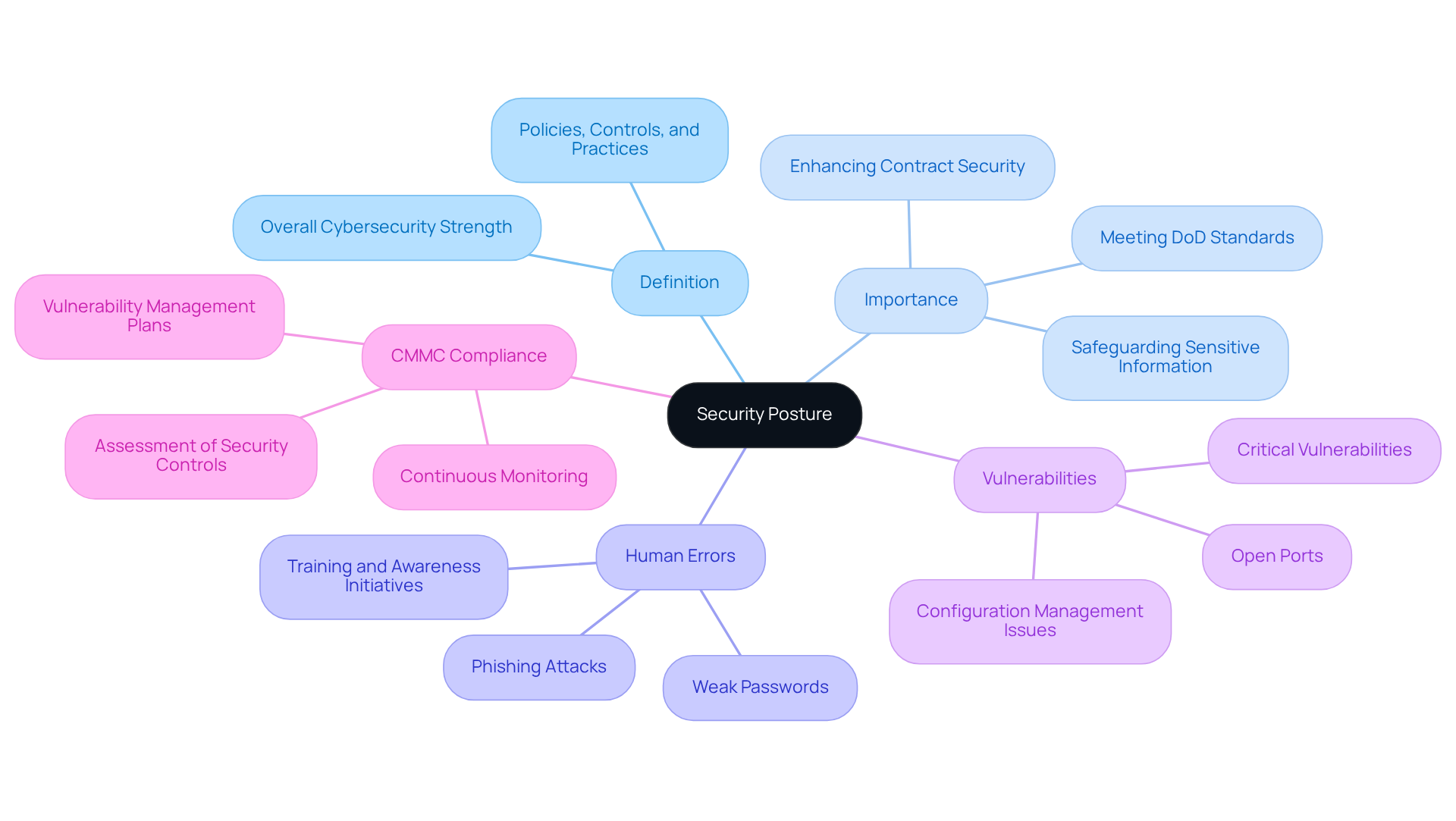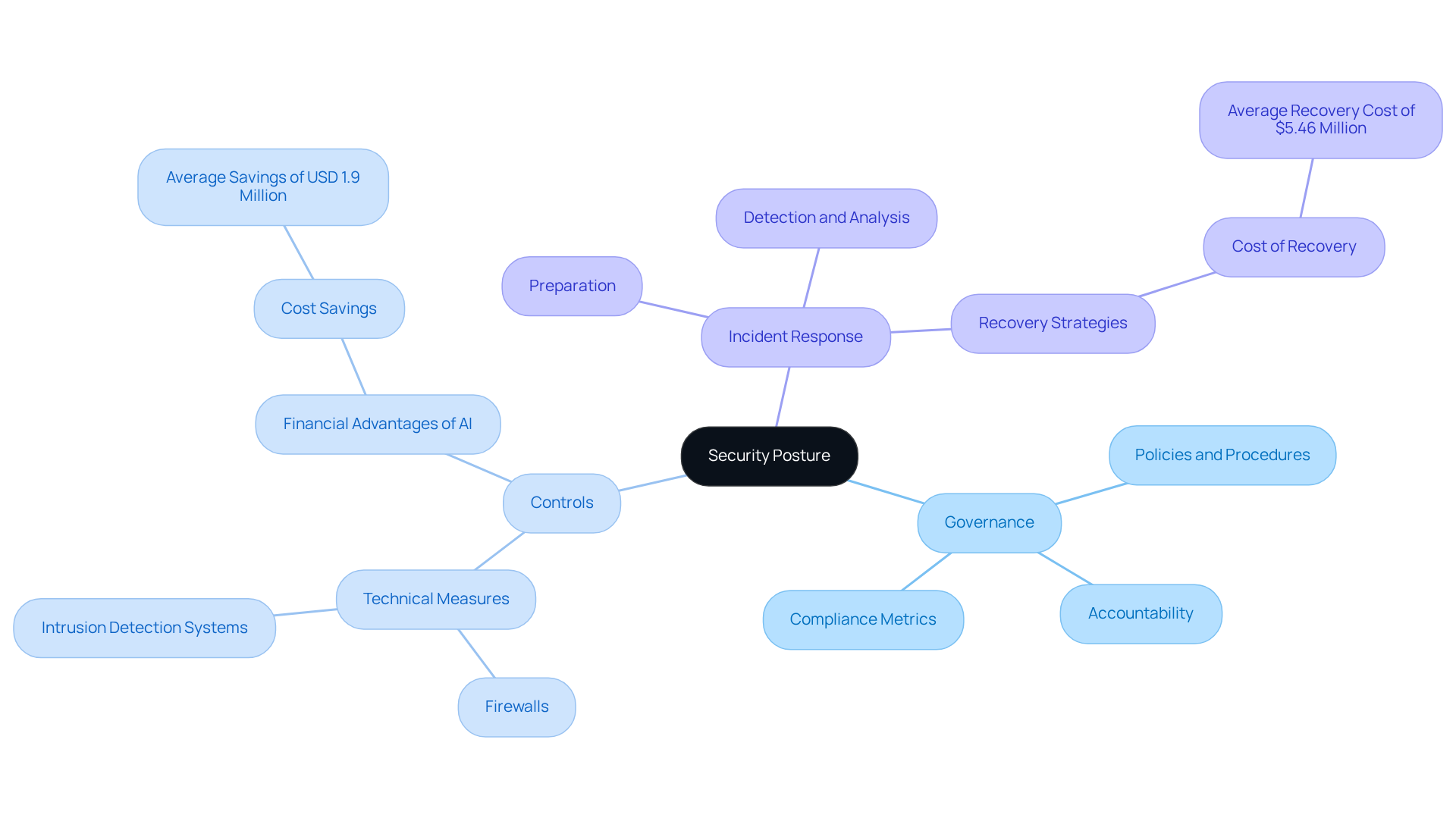Understanding Security Posture Definition for Defense Contractors
Explore the security posture definition crucial for defense contractors to enhance cybersecurity.

Overview
The article defines the security posture for defense contractors, underscoring its critical role in mitigating cyber threats and ensuring compliance with Department of Defense standards. Why is this important? A robust security posture not only safeguards sensitive information but also enhances contractors' ability to secure defense contracts and comply with CMMC regulations.
Key components of an effective security posture include:
- Governance
- Controls
- Incident response
Governance establishes the framework for security policies, while controls are the measures put in place to protect data. Incident response outlines the steps to take when a security breach occurs. Together, these elements create a comprehensive approach to security that is essential for any defense contractor.
Moreover, understanding and implementing these components can significantly impact a contractor's success in the defense sector. By prioritizing security posture, contractors can not only protect their assets but also position themselves favorably in the competitive landscape of defense contracts.
In conclusion, defense contractors must take proactive steps to enhance their security posture. This involves not just compliance with CMMC regulations but also a commitment to continuous improvement in their security practices. Are you ready to take action and ensure your organization meets these critical standards?
Introduction
Understanding the security posture is crucial for defense contractors navigating the complex landscape of cybersecurity. This concept encapsulates the overall strength of an organization’s defenses, including the policies and practices essential for protecting sensitive information and meeting stringent Department of Defense standards. With a staggering 90% of cyber incidents arising from human error, the challenge extends beyond establishing robust defenses; it also involves fostering a culture of awareness and compliance.
How can defense contractors effectively enhance their security posture to mitigate risks and maintain a competitive edge in an ever-evolving threat environment? By prioritizing comprehensive training and awareness programs, organizations can significantly reduce the likelihood of human error. Additionally, implementing regular assessments and updates to security protocols ensures that defenses remain strong against emerging threats.
In this dynamic landscape, it’s not just about having the right tools; it’s about cultivating a proactive mindset throughout the organization. By doing so, defense contractors can not only protect sensitive information but also position themselves as leaders in compliance and security.
Define Security Posture: Core Concepts and Importance
The security posture definition encapsulates the overall cybersecurity strength of an entity, including its policies, controls, and practices designed to mitigate cyber threats. For contractors in the military sector, establishing a robust protective stance is essential—not just for safeguarding sensitive information but also for meeting the stringent standards set by the Department of Defense (DoD). A well-defined protective stance enables organizations to identify weaknesses, implement necessary measures, and respond effectively to incidents, thereby enhancing their capacity to secure contracts and comply with CMMC standards.
Why is a strong defensive stance so critical? Consider this: 90% of all cyber incidents stem from human errors or actions, such as weak passwords or falling victim to phishing attacks. This statistic underscores the urgent need for comprehensive training and awareness initiatives to bolster organizational defenses. Additionally, entities with larger network infrastructures often exhibit poorer cybersecurity performance, highlighting the necessity for contractors to prioritize their protective stance to mitigate risks associated with a broader attack surface.
Case studies reveal that defense contractors, when compared to non-defense firms, frequently encounter vulnerabilities, emphasizing the need for improved protective measures. For instance, a recent review found that many entities within the Defense Industrial Base (DIB) have not addressed critical vulnerabilities, particularly those related to configuration management. This inaction can significantly impact compliance with CMMC standards, as entities at Level 2 or above must develop strategies for vulnerability management and oversee protective measures.
In conclusion, understanding and enhancing the security posture definition is a foundational step for contractors seeking to navigate the complexities of CMMC compliance effectively. By aligning their cybersecurity strategies with regulatory expectations, companies can better safeguard their critical assets and maintain a competitive edge in securing defense contracts. Furthermore, it is crucial for organizations to validate information from external sources, as links to such resources may not imply endorsement and could affect the overall understanding of risk posture.

Explore Types of Security Posture: Data, Cloud, and Identity
-
Data Security Posture: Protecting sensitive information from unauthorized access and breaches is crucial, particularly in light of CMMC regulations. Effective strategies include implementing encryption, robust access controls, and data loss prevention measures to maintain data integrity and confidentiality. Understanding the specific CMMC controls related to data protection is essential for defense contractors, as it serves as a roadmap for achieving compliance and safeguarding defense contracts.
-
Cloud Protection Posture: As organizations increasingly transition to cloud environments, managing cloud protection posture becomes vital. This involves overseeing configurations, ensuring compliance with cloud service providers, and applying protective measures tailored to the unique challenges of cloud infrastructure. To effectively protect sensitive data, a thorough understanding of cloud security measures is necessary to meet CMMC requirements.
-
Identity Security Posture: Safeguarding user identities and managing access effectively is key to fulfilling CMMC Level 1 requirements. Essential practices include implementing multi-factor authentication, establishing identity governance frameworks, and continuously monitoring user activities to prevent unauthorized access and identity theft. Familiarity with FAR 52.204-21 is critical for contractors to ensure they meet the safeguarding criteria for CMMC Level 1.
By understanding the security posture definition and addressing these protective postures, defense contractors can develop targeted strategies to mitigate vulnerabilities and enhance their cybersecurity frameworks. This proactive approach not only ensures compliance with stringent defense industry standards but also fortifies their overall security posture.

Identify Key Components of Security Posture: Governance, Controls, and Incident Response
-
Governance: Establishing robust governance is essential for directing an organization's cybersecurity initiatives through comprehensive policies and procedures. This efficient governance ensures that all stakeholders understand their roles and responsibilities, fostering a culture of accountability in safeguarding safety. With 64% of compliance leaders prioritizing the assessment of program effectiveness in 2025, effective governance not only aligns cybersecurity initiatives with organizational goals but also enhances the tracking of compliance metrics. This alignment ultimately leads to improved protective outcomes.
-
Controls: Controls refer to the technical and administrative measures designed to protect information systems. These measures can include firewalls, intrusion detection systems, and regular evaluations to identify and mitigate risks. Notably, organizations that leverage AI and automation for protection can save an average of USD 1.9 million in breach expenses compared to those that do not utilize such technologies. This significant financial advantage underscores the necessity of establishing effective measures to bolster defense posture and minimize potential losses from breaches.
-
Incident Response: A well-defined incident response strategy is crucial for mitigating the impact of breaches. This plan should encompass preparation for potential incidents, detection and analysis of threats, and execution of a response strategy to recover from attacks. The City of Hamilton's experience with a major cybersecurity breach highlights the critical importance of having robust incident response strategies in place. Had a more efficient incident response strategy been implemented, the city could have reduced damage and lowered recovery expenses, which average $5.46 million per breach in the security sector.
By focusing on these essential elements, defense contractors can establish a strong security posture definition that not only meets regulatory requirements but also significantly enhances their overall cybersecurity strength.

Assess Risks and Challenges in Security Posture Management
Organizations must conduct regular assessments to identify vulnerabilities within their systems that cyber threats could exploit. This involves executing penetration testing and vulnerability evaluations to reveal flaws that could jeopardize safety.
The complex landscape of cybersecurity regulations presents significant challenges. Defense contractors must stay alert regarding alterations in CMMC requirements. Are your protective measures consistently aligned with these evolving standards? Staying compliant is crucial to avoid regulatory pitfalls.
Numerous entities face constraints in funding and staff, obstructing the execution of thorough protective measures. By prioritizing safety initiatives based on comprehensive risk evaluations and utilizing Plans of Action and Milestones (POA&Ms) to document compliance gaps, organizations can allocate resources more effectively. Addressing the most critical vulnerabilities first is essential for a robust defense.
The cyber threat environment is in continual change. Are you adjusting your protective stance in response? Staying informed about the latest threats and trends is essential for maintaining strong protection against potential attacks.
By systematically assessing these risks and challenges, defense contractors can cultivate a proactive approach to security posture definition and management. This ensures they are well-equipped to confront potential threats while adhering to regulatory requirements. Furthermore, utilizing external resources and connections can offer valuable insights and tools to assist in meeting compliance needs. As Charlie Sciuto, Chief Information Security Officer, noted, "With DOJ enforcement rising, whistleblowers increasingly informed and motivated, and CMMC closing the loop to verify compliance, companies in the DIB face a new standard of accountability.

Conclusion
A comprehensive understanding of security posture is vital for defense contractors navigating the complexities of cybersecurity. By defining and enhancing their security posture, these organizations can protect sensitive information and align their practices with the stringent requirements set forth by the Department of Defense. Establishing a strong defensive stance is essential for identifying vulnerabilities, implementing effective controls, and responding to incidents. This ultimately fortifies their ability to secure contracts and comply with CMMC standards.
Throughout this article, we explored key components of security posture, such as governance, controls, and incident response. The significance of data, cloud, and identity security postures was emphasized, highlighting the necessity for contractors to adopt targeted strategies that address specific vulnerabilities. Regular risk assessments and adapting to evolving threats are crucial practices for maintaining a robust security posture that meets regulatory expectations.
In light of the increasing cyber threats and regulatory scrutiny facing defense contractors, the call to action is clear: prioritize the enhancement of security posture through continuous improvement and proactive measures. By investing in comprehensive training, effective governance, and advanced protective technologies, organizations can safeguard their critical assets and position themselves for success in a competitive defense landscape. Embracing this proactive approach is essential for navigating the challenges of the cybersecurity environment and ensuring compliance with the evolving standards of the industry.
Frequently Asked Questions
What is the definition of security posture?
Security posture refers to the overall cybersecurity strength of an entity, encompassing its policies, controls, and practices designed to mitigate cyber threats.
Why is establishing a strong security posture important for military contractors?
A robust security posture is essential for military contractors to safeguard sensitive information and meet the stringent standards set by the Department of Defense (DoD). It helps organizations identify weaknesses, implement necessary measures, and respond effectively to incidents.
What percentage of cyber incidents are attributed to human errors?
90% of all cyber incidents stem from human errors or actions, such as weak passwords or falling victim to phishing attacks.
How does network infrastructure size affect cybersecurity performance?
Entities with larger network infrastructures often exhibit poorer cybersecurity performance, indicating the need for contractors to prioritize their protective stance to mitigate risks associated with a broader attack surface.
What vulnerabilities do defense contractors face compared to non-defense firms?
Defense contractors frequently encounter vulnerabilities that emphasize the need for improved protective measures, particularly in areas such as configuration management.
What is the significance of compliance with CMMC standards for contractors?
Compliance with CMMC standards is crucial as entities at Level 2 or above must develop strategies for vulnerability management and oversee protective measures to maintain their contracts.
How can organizations enhance their security posture for better compliance?
Organizations can enhance their security posture by aligning their cybersecurity strategies with regulatory expectations, thereby better safeguarding their critical assets and maintaining a competitive edge in securing defense contracts.
What should organizations be cautious about regarding external information sources?
Organizations should validate information from external sources, as links to such resources may not imply endorsement and could affect the overall understanding of their risk posture.




